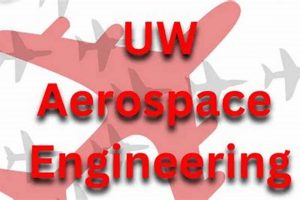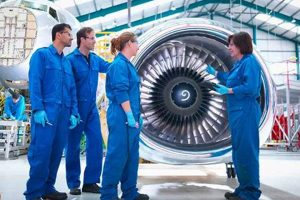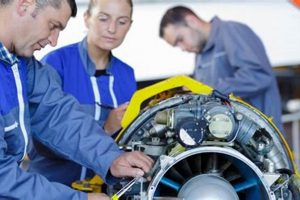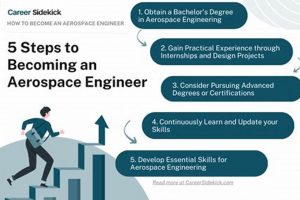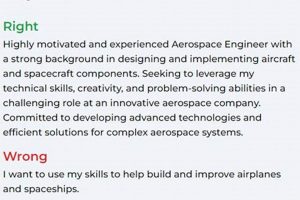The specifications sought when filling technical roles at the prominent space exploration and technology company include a robust understanding of aerospace engineering principles, coupled with demonstrable experience in relevant areas such as propulsion systems, structural analysis, or avionics. For instance, a candidate for a propulsion engineer position may need a strong background in thermodynamics and fluid mechanics, as well as hands-on experience with rocket engine design and testing.
These benchmarks are vital for maintaining the company’s innovative edge and ensuring the reliability and safety of its space missions. Historically, the company has sought individuals with a proven track record of problem-solving and a passion for pushing the boundaries of space technology. Meeting these expectations is essential for contributing to the advancement of space exploration and the company’s ambitious goals.
The subsequent sections will delve into specific academic qualifications, crucial technical proficiencies, desired soft skills, and the typical interview process associated with obtaining an engineering position within the organization.Each of these facets plays a critical role in determining a candidate’s suitability for contributing to the company’s mission.
Guidance for Aspiring Aerospace Engineers
This section outlines key considerations for individuals aiming to fulfill the demanding standards for an aerospace engineering position at the renowned space technology corporation.
Tip 1: Cultivate a Deep Technical Foundation: A strong understanding of fundamental engineering principles, including thermodynamics, fluid mechanics, materials science, and control systems, is paramount. This should be supplemented with specialized knowledge in areas relevant to the target role, such as orbital mechanics or spacecraft design.
Tip 2: Gain Hands-On Experience: Practical experience through internships, research projects, or participation in engineering competitions (e.g., rocketry challenges) provides invaluable exposure to real-world engineering problems and demonstrates the ability to apply theoretical knowledge.
Tip 3: Master Relevant Software Tools: Proficiency in industry-standard software for CAD (Computer-Aided Design), CAE (Computer-Aided Engineering), and simulation is expected. Examples include SolidWorks, ANSYS, MATLAB, and STK (Systems Tool Kit).
Tip 4: Develop Strong Problem-Solving Skills: The ability to analyze complex engineering challenges, identify root causes, and develop innovative solutions is critical. This involves a systematic approach to problem-solving and a willingness to challenge conventional thinking.
Tip 5: Demonstrate a Passion for Space Exploration: A genuine interest in space technology and the company’s mission is highly valued. This can be demonstrated through personal projects, involvement in space-related organizations, or a comprehensive understanding of the company’s history and achievements.
Tip 6: Hone Communication Skills: The ability to effectively communicate technical information, both verbally and in writing, is essential for collaborating with engineers and presenting findings to stakeholders. Clear and concise communication is crucial for project success.
Tip 7: Highlight Relevant Projects and Accomplishments: When applying and interviewing, emphasize projects and accomplishments that directly align with the responsibilities of the target role. Quantify achievements whenever possible to demonstrate impact and value.
Adhering to these guidelines can significantly improve an applicant’s chances of success in securing a challenging and rewarding aerospace engineering position. These actions showcase a serious dedication to aerospace engineering.
The following sections will address other factors that contribute to a successful application, including academic qualifications and the interview process.
1. Academic Qualifications
Academic qualifications form the bedrock upon which an aerospace engineer’s skill set is built, playing a crucial role in meeting the stringent criteria for positions at the company. A rigorous academic background equips candidates with the fundamental knowledge and analytical abilities necessary to contribute to the company’s ambitious projects.
- Bachelor’s Degree in Aerospace Engineering or a Related Field
A bachelor’s degree is generally the minimum educational requirement. Programs in aerospace engineering, mechanical engineering, or a closely related discipline provide the foundational knowledge in areas such as aerodynamics, propulsion, structures, and control systems. Coursework should include a strong emphasis on mathematics, physics, and computer science. For example, a course in fluid dynamics equips an engineer to analyze airflow around aircraft components, a skill directly applicable to designing more efficient spacecraft. A solid performance in these core subjects is indicative of an individual’s ability to grasp complex concepts.
- Advanced Degrees (Master’s or Ph.D.)
For more specialized roles or research-oriented positions, advanced degrees are often preferred, if not required. A master’s or doctoral program allows for in-depth study and research in a specific area of aerospace engineering, such as advanced propulsion systems, composite materials, or autonomous control. Theses or dissertations should demonstrate the ability to conduct independent research, analyze data, and draw meaningful conclusions. For instance, a Ph.D. candidate who developed a novel algorithm for optimizing rocket trajectory would possess highly sought-after expertise.
- Accreditation and Reputation of the Institution
The accreditation of the university or college is important. ABET accreditation, in particular, signals that the program meets specific quality standards for engineering education. Furthermore, the reputation of the institution from which the degree was earned can influence hiring decisions. Graduates from universities with strong aerospace engineering programs and a track record of producing successful engineers are often highly regarded.
- Relevant Coursework and Projects
Beyond the degree itself, the specific coursework and projects undertaken are meticulously reviewed. Emphasis should be placed on those relevant to the desired role within the company. For example, a structural engineer applicant should have a strong background in finite element analysis and experience with designing lightweight structures. Successful completion of capstone projects, participation in engineering design competitions, and independent research demonstrate initiative and practical skills.
In summary, academic qualifications serve as a primary indicator of a candidate’s readiness to tackle the complex challenges inherent in space exploration. These qualifications showcase fundamental concepts, dedication, and analytical skill, setting the stage for future contributions to the company. The strength and relevance of these qualifications significantly influence the potential for securing a position and contributing meaningfully to its engineering endeavors.
2. Technical Proficiency
Technical proficiency is an indispensable element of the skill set sought in aerospace engineering candidates. Its connection to the stringent specifications is direct: without a demonstrable mastery of relevant technical domains, an applicants candidacy is significantly weakened. Technical competency directly impacts an engineer’s capacity to contribute meaningfully to design, analysis, and testing activities, all of which are central to the company’s operations. For instance, an engineer tasked with designing a heat shield must exhibit proficiency in computational fluid dynamics (CFD) and heat transfer analysis. The ability to accurately simulate the extreme thermal conditions experienced during atmospheric re-entry is critical to ensuring the shield’s integrity and, consequently, the safety of the mission.
The organization’s pioneering endeavors in reusable rocket technology demand a workforce equipped with specialized skills. This includes expertise in areas such as advanced materials, propulsion systems, and avionics. Consider the development of the Raptor engine: Engineers involved in this project require in-depth knowledge of combustion processes, turbomachinery design, and control systems. These complex systems require engineers with expertise that goes beyond theoretical concepts. Moreover, experience with simulation software, data analysis tools, and hardware testing methodologies is essential for validating designs and identifying potential issues before launch. The continuous pursuit of innovation requires engineers to be adaptable, resourceful, and committed to lifelong learning.
In summary, technical proficiency is a non-negotiable attribute for aerospace engineers contributing to space exploration. The complexities of space travel and the rapid pace of technological advancement demand a highly skilled and technically competent workforce. Challenges persist in ensuring that engineers maintain up-to-date knowledge and skills in a rapidly evolving field. However, investing in training programs and fostering a culture of continuous learning are crucial for sustaining the companys competitive advantage and for achieving its ambitious goals in space exploration.
3. Problem-solving Aptitude
Problem-solving aptitude constitutes a core attribute within the desired skillset. Its presence, or lack thereof, directly influences a candidate’s viability. Aerospace engineering inherently involves navigating multifaceted technical challenges, from optimizing structural designs to mitigating risks associated with spaceflight. A demonstrable capacity for problem-solving is therefore not merely desirable but essential. For example, anomalies encountered during rocket engine testing necessitate a systematic approach to identify root causes, develop corrective actions, and prevent recurrence. An engineer with a strong problem-solving aptitude approaches such situations with analytical rigor and creative thinking.
The significance of problem-solving extends beyond reactive troubleshooting to proactive design and optimization. The company’s emphasis on rapid iteration and continuous improvement demands engineers who can identify opportunities for enhancing performance, reducing costs, or improving reliability. This may involve developing novel algorithms for trajectory optimization, devising innovative solutions for thermal management, or implementing more efficient manufacturing processes. The ability to think critically, challenge assumptions, and propose viable alternatives is crucial for driving innovation within the organization. Consider the challenge of reducing the weight of a spacecraft: engineers with strong problem-solving capabilities might explore alternative materials, optimize structural topology, or implement advanced manufacturing techniques such as additive manufacturing.
In summary, problem-solving aptitude is inextricably linked to fulfilling the stringent requirements for aerospace engineering positions. It enables engineers to effectively address technical challenges, drive innovation, and contribute to the company’s mission of advancing space exploration. Cultivating and showcasing this aptitude is a crucial element of a successful application. Possessing a robust analytical approach ensures the applicant can handle challenges.
4. Relevant experience
Relevant experience serves as a critical bridge connecting academic knowledge to practical application, thereby directly addressing the specifications of roles at the organization. Theoretical proficiency alone proves insufficient; demonstrable experience in applying engineering principles within real-world contexts is paramount. For instance, a candidate vying for a position on the Starship development team benefits substantially from previous involvement in projects involving composite structures, cryogenic propulsion, or flight control systems. The demonstrated ability to translate design concepts into tangible hardware and to troubleshoot issues during testing provides compelling evidence of preparedness.
The evaluation of relevant experience extends beyond mere participation in projects. Employers closely scrutinize the depth and breadth of involvement, the challenges overcome, and the quantifiable results achieved. A candidate who led a student rocketry team to a successful launch demonstrates not only technical competence but also leadership skills and the ability to manage complex projects under pressure. Similarly, experience with industry-standard software tools and hardware platforms enhances a candidate’s immediate value to the organization. Proficiency in computational fluid dynamics (CFD) software, finite element analysis (FEA) tools, or experience with rapid prototyping techniques allows for immediate contribution to ongoing projects.
In summary, relevant experience is inextricably linked to the required competencies. It provides tangible proof of a candidate’s ability to apply engineering principles, overcome technical challenges, and contribute to the organization’s ambitious goals. The emphasis on practical experience reflects the company’s commitment to innovation and its reliance on engineers who can seamlessly integrate theoretical knowledge with real-world problem-solving. Possessing practical experience is a testament to one’s ability to learn.
5. Cultural alignment
Cultural alignment represents a crucial, yet often understated, dimension when evaluating candidates. Its significance stems from the company’s unique operational tempo and organizational ethos, impacting an individual’s capacity to integrate effectively and contribute meaningfully.
- Adaptability and Resilience
The organization’s environment demands adaptability in the face of rapidly changing priorities and unforeseen technical challenges. An ideal candidate demonstrates resilience, maintaining composure and focus under pressure. For example, adapting to new testing protocols on short notice or re-evaluating design parameters based on unexpected data findings highlights adaptability and resilience.
- Bias for Action and Innovation
A preference for proactive problem-solving and a relentless pursuit of innovation are vital characteristics. The company fosters a culture where engineers are encouraged to challenge conventional wisdom and propose novel solutions. Contributing to internal research and development projects or suggesting process improvements demonstrates a bias for action and innovation.
- Collaborative Spirit and Communication Skills
Aerospace engineering projects are inherently collaborative, necessitating effective communication and teamwork. The capacity to articulate technical concepts clearly and concisely, as well as to actively listen and incorporate feedback, is crucial. Effectively communicating the results of a structural analysis or working with other team members to resolve a technical challenge exemplifies this skill.
- Commitment to the Mission and Values
A genuine passion for space exploration and a deep understanding of the organization’s mission and values are highly valued. A demonstrated commitment to pushing the boundaries of technology and contributing to the advancement of human spaceflight underscores cultural compatibility.
Cultural alignment, therefore, represents an integral dimension of the assessment process. Demonstrating adaptability, a bias for action, collaborative spirit, and a deep commitment to the company’s mission substantially enhances an applicant’s prospects, complementing the more overtly technical qualifications and experience.
Frequently Asked Questions Regarding Essential Qualifications
The following addresses common inquiries pertaining to the skills and experience expected of aerospace engineers seeking employment. This seeks to clarify ambiguities and provide insights into expectations.
Question 1: What is the minimum educational requirement?
A bachelor’s degree in aerospace engineering, or a closely related field such as mechanical engineering, is generally the baseline requirement. However, specific roles, particularly those involving research or advanced design, may necessitate a master’s degree or doctorate.
Question 2: How important is practical experience versus academic achievement?
Both are critical. A strong academic foundation provides the theoretical knowledge base, while relevant experience demonstrates the ability to apply that knowledge to real-world problems. A balance between the two is often sought.
Question 3: What specific software skills are most valued?
Proficiency with industry-standard tools for CAD (Computer-Aided Design), CAE (Computer-Aided Engineering), and simulation is highly desirable. Examples include SolidWorks, ANSYS, MATLAB, and STK (Systems Tool Kit).
Question 4: Is prior experience in the space industry a necessity?
While direct experience is advantageous, it is not always mandatory. Strong candidates with relevant experience in other engineering fields may also be considered, particularly if they demonstrate a strong interest in space technology and a willingness to learn.
Question 5: What non-technical skills are considered important?
Effective communication, teamwork, problem-solving, and adaptability are all highly valued. The ability to work effectively in a fast-paced, collaborative environment is essential.
Question 6: How does the company assess cultural fit?
The interview process is designed to evaluate not only technical skills but also cultural alignment. Questions may focus on problem-solving approaches, teamwork experiences, and the candidate’s understanding of the company’s mission and values.
In essence, a combination of academic excellence, practical experience, technical skills, and cultural alignment is what contributes to fulfilling the roles expectations. A well-rounded candidate is key.
The following section will provide guidance on navigating the interview process.
Conclusion
The preceding exploration of “spacex aerospace engineer requirements” underscores the multifaceted nature of securing and excelling in such a position. Academic qualifications, technical proficiency, problem-solving aptitude, relevant experience, and cultural alignment collectively define the characteristics of successful candidates. These elements are not mutually exclusive but rather interdependent, contributing to a holistic assessment of an individual’s potential.
Aspiring engineers should diligently cultivate these attributes, recognizing that the pursuit of space exploration demands a dedication to continuous learning and innovation. Adherence to these rigorous standards is essential for contributing to the advancement of space technology and realizing ambitious goals in the field.


